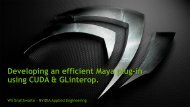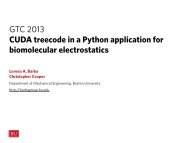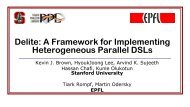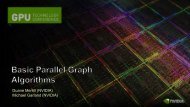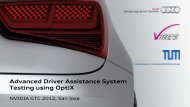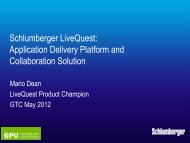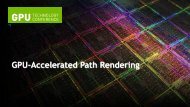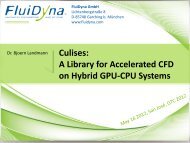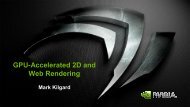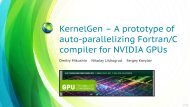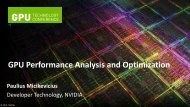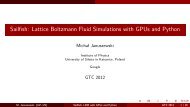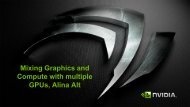Particle Dynamics with MBD and FEA Using CUDA
Particle Dynamics with MBD and FEA Using CUDA
Particle Dynamics with MBD and FEA Using CUDA
You also want an ePaper? Increase the reach of your titles
YUMPU automatically turns print PDFs into web optimized ePapers that Google loves.
What is MFBD Used For?• Design– Motion prediction– Durability– Optimization– Safety factor– Control systems• Performance analysis– Failure analysis• Key reasons for MFBD:– When motion & system levelanalysis are important– High-speed, complex contact,complex boundary conditionsc 2012 FunctionBay, Inc.
The MFBD Environment• Strong coupling of system variables– Nonlinear systems• Rotation, nonlinear constraints• Nonlinear deformation, materials• Implicit differential-algebraicequation (DAE) solvers– Alpha-family of steppers• Newmark, generalized-alpha– Requires heavy use of Newton-Raphson nonlinear system solvers• Sparse direct multi-frontal linearsystem solver• Small systems of equations– 1,000’s ~ 1,000,000’s of variables• Long simulation times– 1,000’s ~ 1,000,000’s of time stepseeFee T Fer T Φee0 Φreqq eeeq qq F eeΦ e 0 0 0 0 ee ee q λ Φ F F q F r r rr rT rrT T erT 0 B Φe r zB Φzrr rr q q λ Φrr0 0 Φer err 0 0 qλ ΦererΦ e 0 Φ r 0 0 qq c 2012 FunctionBay, Inc.
MFBD + GPU Computing• Goal:– Add value to MFBDthrough thecomputational power ofthe GPU.• First application:– <strong>Particle</strong> dynamicsc 2012 FunctionBay, Inc.
<strong>Particle</strong> <strong>Dynamics</strong> for MFBD• <strong>Particle</strong>s:– High value for MFBD code• Solve more complex problems• Earthmovers, lubrication, wheel-soil interaction, tank sloshing, toner systems …Vehicle model courtesy of Jacob Hustadc 2012 FunctionBay, Inc.
<strong>Particle</strong> <strong>Dynamics</strong> for MFBD• <strong>Particle</strong>s:– Expensive on the CPU• More particles = more useful• Huge number of particles & variables• Loose coupling of equations• <strong>Particle</strong>s interact through forces (not joints)– Excellent fit for GPU computing– Implementation cost relatively low• <strong>Particle</strong> formulations:– Granular solids: DEM (Discrete element method)• Dirt, s<strong>and</strong>, rocks, toner– Fluids: SPH (Smoothed particle hydrodynamics)• Lubrication, flows, slosh, splashc 2012 FunctionBay, Inc.
Co-Simulation of <strong>Particle</strong>s <strong>and</strong> MFBD• Key Issue: Time stepping– MFBD• CPU• Implicit integrator• Large steps• Variable time step size 10 -2 ~ 10 -4 sec– <strong>Particle</strong>s• GPU• Explicit integrator• Small steps• Fixed time step size 10 -5 ~ 10 -7 secMFBDPositionForces<strong>Particle</strong>c 2012 FunctionBay, Inc.
Co-SimulationPositionMFBD (CPU Side)MFBDForces<strong>Particle</strong><strong>Particle</strong> (GPU Side)c 2012 FunctionBay, Inc.
Co-Simulation Stepping AlgorithmPositionMFBD<strong>Particle</strong>Forces1.Solve MFBD motion from t i to t i+1 .<strong>Particle</strong> contact forces considered constant.3.Solve particle motion between t i <strong>and</strong> t i+1 .Linearly interpolate MFBD contact surfaces from t i to t i+1 .MFBD Step<strong>Particle</strong> Steps2.Transfer MFBD surfacepositions to particle solver(on GPU).t i t i+1 t i t i+14.Transfer particle-to-surface forces at t i+1 to MFBD solverc 2012 FunctionBay, Inc.
<strong>Particle</strong> Stepper• Per step (all on GPU):– Identify contacts– Compute contact forces– Compute positions at next time step• Explicit stepperc 2012 FunctionBay, Inc.
Contact Algorithm Details• <strong>Particle</strong>-to-MFBD-surface contact algorithm:– <strong>Particle</strong> shape: spherical– MFBD body surface: triangles– Contact search: sphere-to-triangle– Force: penalty-basedPenetration depthc 2012 FunctionBay, Inc.
<strong>Particle</strong>-to-MFBD-Surface Contact• Linear interpolation of body position from t i to t i+1– Rigid bodies:• Interpolate center point <strong>and</strong> orientation– Flexible bodies:• Interpolate nodal positionsc 2012 FunctionBay, Inc.
Examples• <strong>Particle</strong> computational performance– Test hardware:• GPU: Tesla C2050• CPU: Intel i5 760 (Quad-core, 2.8GHz)• RAM: 8GB– Test problem:• <strong>Particle</strong> step size: 10 -6 sec• Simulation t end : 1 sec• # time steps: 1,000,000# Spheres ComputationTime (Hours)1,000 0.452,000 0.505,000 0.6710,000 0.9020,000 1.8350,000 4.67100,000 9.12200,000 22.00500,000 46.83c 2012 FunctionBay, Inc.
ExamplesHardware:GPU:CPU:RAM:Tesla C2050Intel i5 760 (Quad-core, 2.8GHz)8GB<strong>Particle</strong>s In Box Waterfall WashingmachineTanker truck Camera Camera Gears# Spheres 9900 52000 25100 53000 8640 10296Radius of Spheres (mm) 6.25 10 6.5 22.5 1 0.15Simulation t end (sec) 0.3 2 2 5 3 1<strong>MBD</strong> Step Size (sec) 10 -3 10 -3 10 -3 10 -3 10 -3 10 -3<strong>Particle</strong> Step Size (sec) 6.67x10 -6 2.89x10 -6 2.35x10 -6 8.54x10 -6 6.67x10 -6 5.82x10 -9Comp. Time (hours) 0.27 5.85 4.5 4.4 3.67 24.0c 2012 FunctionBay, Inc.
Implementation Status, Future Direction• Current Status:– DEM + <strong>MBD</strong> (rigid only)– Single GPU only• Next Targets:– MFBD (add flexible body interaction)– SPH– Multi-GPU supportc 2012 FunctionBay, Inc.
Conclusion• <strong>Particle</strong> <strong>Dynamics</strong>:– Adds high value to MFBD– Excellent match for GPU computing– Low implementation cost– Co-simulation to combine MFBD solver <strong>and</strong> particle solverc 2012 FunctionBay, Inc.
Thank Youc 2012 FunctionBay, Inc.



